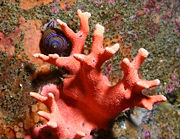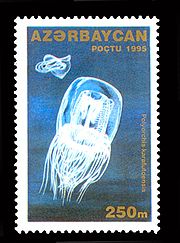
Anthomedusae
Encyclopedia
Anthomedusae or Anthomedusa, the athecate hydroids, are an order
of the Hydrozoa
, a class
of marine invertebrate
s belonging to the phylum Cnidaria
. A profusion of alternate scientific names exists for this long-known, heavily discussed and spectactular group - it has also been called Gymnoblastea, or, with or without an emended ending "-ae", Anthoathecata, Athecata, Hydromedusa or Stylasterina. There are about 1,200 species
worldwide.
These hydrozoans always have a polyp
stage. Their hydranths grow either solitary or in colonies. There is no firm perisarc around the polyp body. The medusa
e, or jellyfish
, are solitary animals, with tentacles arising from the bell margin, lacking statocyst
s but possessing radial canals. Their gonad
s are on the manubrium ("handle").
Except in Eudendriidae and Laingiidae, the cnidome has desmonemes.
 Their close relationship to the Leptomedusae
Their close relationship to the Leptomedusae
has been long known, but it was formerly believed that these two were also close to the Limnomedusae. Actually, their closest relative are the highly advanced Siphonophorae, whereas the Limnomedusae are simply a rather primitive group that is not very closely related to these three Leptolinae
but might actually belong to the Trachylinae
subclass
. The family
Clathrozoellidae is placed with the Filifera in some treatments; in others it is placed in the Leptomedusae and sometimes even synonymized with their family Clathrozoidae. The supposed athecate family Monobrachiidae apparently belongs in the Olindiasidae of the Limnomedusae.
The Porpitidae are highly aberrant group, and were at one time considered an own order "Chondrophora". But actually they are derived from Zancleida. Halammohydridae and Otohydridae, sometimes placed here, actually appear to be trachyline
hydrozoans of the order Actinulidae. Similarly, the Laingiidae, also long considered a distinct order Laingiomedusae, might belong in the Pandeida.
Anthomedusae



Order (biology)
In scientific classification used in biology, the order is# a taxonomic rank used in the classification of organisms. Other well-known ranks are life, domain, kingdom, phylum, class, family, genus, and species, with order fitting in between class and family...
of the Hydrozoa
Hydrozoa
Hydrozoa are a taxonomic class of very small, predatory animals which can be solitary or colonial and which mostly live in saltwater. A few genera within this class live in freshwater...
, a class
Class (biology)
In biological classification, class is* a taxonomic rank. Other well-known ranks are life, domain, kingdom, phylum, order, family, genus, and species, with class fitting between phylum and order...
of marine invertebrate
Invertebrate
An invertebrate is an animal without a backbone. The group includes 97% of all animal species – all animals except those in the chordate subphylum Vertebrata .Invertebrates form a paraphyletic group...
s belonging to the phylum Cnidaria
Cnidaria
Cnidaria is a phylum containing over 9,000 species of animals found exclusively in aquatic and mostly marine environments. Their distinguishing feature is cnidocytes, specialized cells that they use mainly for capturing prey. Their bodies consist of mesoglea, a non-living jelly-like substance,...
. A profusion of alternate scientific names exists for this long-known, heavily discussed and spectactular group - it has also been called Gymnoblastea, or, with or without an emended ending "-ae", Anthoathecata, Athecata, Hydromedusa or Stylasterina. There are about 1,200 species
Species
In biology, a species is one of the basic units of biological classification and a taxonomic rank. A species is often defined as a group of organisms capable of interbreeding and producing fertile offspring. While in many cases this definition is adequate, more precise or differing measures are...
worldwide.
These hydrozoans always have a polyp
Polyp
A polyp in zoology is one of two forms found in the phylum Cnidaria, the other being the medusa. Polyps are approximately cylindrical in shape and elongated at the axis of the body...
stage. Their hydranths grow either solitary or in colonies. There is no firm perisarc around the polyp body. The medusa
Medusa (biology)
In biology, a medusa is a form of cnidarian in which the body is shaped like an umbrella, in contrast with polyps. Medusae vary from bell-shaped to the shape of a thin disk, scarcely convex above and only slightly concave below...
e, or jellyfish
Jellyfish
Jellyfish are free-swimming members of the phylum Cnidaria. Medusa is another word for jellyfish, and refers to any free-swimming jellyfish stages in the phylum Cnidaria...
, are solitary animals, with tentacles arising from the bell margin, lacking statocyst
Statocyst
The statocyst is a balance sensory receptor present in some aquatic invertebrates, including bivalves, cnidarians, echinoderms, cephalopods, and crustaceans. A similar structure is also found in Xenoturbella. The statocyst consists of a sac-like structure containing a mineralised mass and numerous...
s but possessing radial canals. Their gonad
Gonad
The gonad is the organ that makes gametes. The gonads in males are the testes and the gonads in females are the ovaries. The product, gametes, are haploid germ cells. For example, spermatozoon and egg cells are gametes...
s are on the manubrium ("handle").
Except in Eudendriidae and Laingiidae, the cnidome has desmonemes.
Systematics

Leptomedusae
Leptomedusae or Leptomedusa, commonly called thecate hydroids, are a cnidarian order in the subclass Leptolinae. They were formerly placed at suborder rank in the paraphyletic "Hydroida"...
has been long known, but it was formerly believed that these two were also close to the Limnomedusae. Actually, their closest relative are the highly advanced Siphonophorae, whereas the Limnomedusae are simply a rather primitive group that is not very closely related to these three Leptolinae
Leptolinae
Leptolinae are a cnidarian subclass of the Hydrozoa. They contain the bulk of the paraphyletic "Hydroida" which were one of the main groupings of the Hydrozoa in older classifications and were placed at order rank...
but might actually belong to the Trachylinae
Trachylinae
Trachylinae are a cnidarian subclass of the Hydrozoa. They are placed at order rank in many older classifications, and limited to contain the Narcomedusae and Trachymedusae...
subclass
Class (biology)
In biological classification, class is* a taxonomic rank. Other well-known ranks are life, domain, kingdom, phylum, order, family, genus, and species, with class fitting between phylum and order...
. The family
Family (biology)
In biological classification, family is* a taxonomic rank. Other well-known ranks are life, domain, kingdom, phylum, class, order, genus, and species, with family fitting between order and genus. As for the other well-known ranks, there is the option of an immediately lower rank, indicated by the...
Clathrozoellidae is placed with the Filifera in some treatments; in others it is placed in the Leptomedusae and sometimes even synonymized with their family Clathrozoidae. The supposed athecate family Monobrachiidae apparently belongs in the Olindiasidae of the Limnomedusae.
The Porpitidae are highly aberrant group, and were at one time considered an own order "Chondrophora". But actually they are derived from Zancleida. Halammohydridae and Otohydridae, sometimes placed here, actually appear to be trachyline
Trachylinae
Trachylinae are a cnidarian subclass of the Hydrozoa. They are placed at order rank in many older classifications, and limited to contain the Narcomedusae and Trachymedusae...
hydrozoans of the order Actinulidae. Similarly, the Laingiidae, also long considered a distinct order Laingiomedusae, might belong in the Pandeida.
Infraorders and families
Basal and incertae sedisIncertae sedis
, is a term used to define a taxonomic group where its broader relationships are unknown or undefined. Uncertainty at specific taxonomic levels is attributed by , , and similar terms.-Examples:*The fossil plant Paradinandra suecica could not be assigned to any...
Anthomedusae
- Genus Gammaria
- Genus Saccohydra
- Family Codonidae
- Family Halimedusidae (Capitata: Moerisiida?)
- Family Halocordylidae
- Family Laingiidae (Filifera: Pandeida? Tentatively placed here)
- Family Myriothelidae (Capitata: Tubulariida? Including Candelabriidae)
- Family Rhysiidae (Filifera: Margelina?)
- Family Russelliidae (Filifera: Pandeida?)
- Family Stylasteridae (Filifera: Margelina?)



